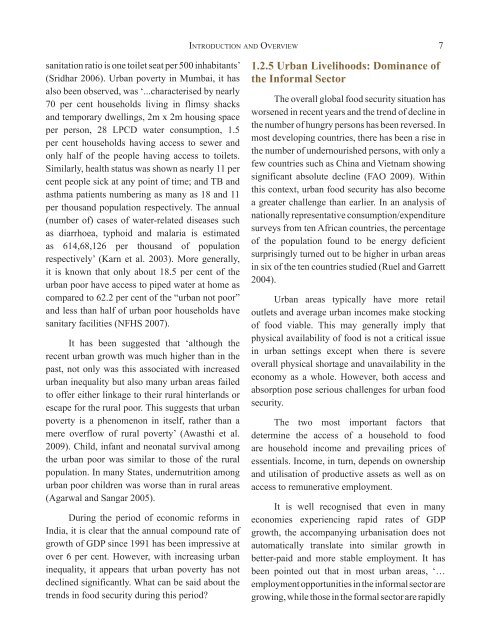Report on the State of Food Insecurity in Urban India, 2010 - M. S. ...
Report on the State of Food Insecurity in Urban India, 2010 - M. S. ...
Report on the State of Food Insecurity in Urban India, 2010 - M. S. ...
You also want an ePaper? Increase the reach of your titles
YUMPU automatically turns print PDFs into web optimized ePapers that Google loves.
sanitati<strong>on</strong> ratio is <strong>on</strong>e toilet seat per 500 <strong>in</strong>habitants’<br />
(Sridhar 2006). <strong>Urban</strong> poverty <strong>in</strong> Mumbai, it has<br />
also been observed, was ‘...characterised by nearly<br />
70 per cent households liv<strong>in</strong>g <strong>in</strong> flimsy shacks<br />
and temporary dwell<strong>in</strong>gs, 2m x 2m hous<strong>in</strong>g space<br />
per pers<strong>on</strong>, 28 LPCD water c<strong>on</strong>sumpti<strong>on</strong>, 1.5<br />
per cent households hav<strong>in</strong>g access to sewer and<br />
<strong>on</strong>ly half <strong>of</strong> <strong>the</strong> people hav<strong>in</strong>g access to toilets.<br />
Similarly, health status was shown as nearly 11 per<br />
cent people sick at any po<strong>in</strong>t <strong>of</strong> time; and TB and<br />
asthma patients number<strong>in</strong>g as many as 18 and 11<br />
per thousand populati<strong>on</strong> respectively. The annual<br />
(number <strong>of</strong>) cases <strong>of</strong> water-related diseases such<br />
as diarrhoea, typhoid and malaria is estimated<br />
as 614,68,126 per thousand <strong>of</strong> populati<strong>on</strong><br />
respectively’ (Karn et al. 2003). More generally,<br />
it is known that <strong>on</strong>ly about 18.5 per cent <strong>of</strong> <strong>the</strong><br />
urban poor have access to piped water at home as<br />
compared to 62.2 per cent <strong>of</strong> <strong>the</strong> “urban not poor”<br />
and less than half <strong>of</strong> urban poor households have<br />
sanitary facilities (NFHS 2007).<br />
It has been suggested that ‘although <strong>the</strong><br />
recent urban growth was much higher than <strong>in</strong> <strong>the</strong><br />
past, not <strong>on</strong>ly was this associated with <strong>in</strong>creased<br />
urban <strong>in</strong>equality but also many urban areas failed<br />
to <strong>of</strong>fer ei<strong>the</strong>r l<strong>in</strong>kage to <strong>the</strong>ir rural h<strong>in</strong>terlands or<br />
escape for <strong>the</strong> rural poor. This suggests that urban<br />
poverty is a phenomen<strong>on</strong> <strong>in</strong> itself, ra<strong>the</strong>r than a<br />
mere overflow <strong>of</strong> rural poverty’ (Awasthi et al.<br />
2009). Child, <strong>in</strong>fant and ne<strong>on</strong>atal survival am<strong>on</strong>g<br />
<strong>the</strong> urban poor was similar to those <strong>of</strong> <strong>the</strong> rural<br />
populati<strong>on</strong>. In many <strong>State</strong>s, undernutriti<strong>on</strong> am<strong>on</strong>g<br />
urban poor children was worse than <strong>in</strong> rural areas<br />
(Agarwal and Sangar 2005).<br />
Dur<strong>in</strong>g <strong>the</strong> period <strong>of</strong> ec<strong>on</strong>omic reforms <strong>in</strong><br />
<strong>India</strong>, it is clear that <strong>the</strong> annual compound rate <strong>of</strong><br />
growth <strong>of</strong> GDP s<strong>in</strong>ce 1991 has been impressive at<br />
over 6 per cent. However, with <strong>in</strong>creas<strong>in</strong>g urban<br />
<strong>in</strong>equality, it appears that urban poverty has not<br />
decl<strong>in</strong>ed significantly. What can be said about <strong>the</strong><br />
trends <strong>in</strong> food security dur<strong>in</strong>g this period?<br />
INTRODUCTION AND OVERVIEW 7<br />
1.2.5 <strong>Urban</strong> Livelihoods: Dom<strong>in</strong>ance <strong>of</strong><br />
<strong>the</strong> Informal Sector<br />
The overall global food security situati<strong>on</strong> has<br />
worsened <strong>in</strong> recent years and <strong>the</strong> trend <strong>of</strong> decl<strong>in</strong>e <strong>in</strong><br />
<strong>the</strong> number <strong>of</strong> hungry pers<strong>on</strong>s has been reversed. In<br />
most develop<strong>in</strong>g countries, <strong>the</strong>re has been a rise <strong>in</strong><br />
<strong>the</strong> number <strong>of</strong> undernourished pers<strong>on</strong>s, with <strong>on</strong>ly a<br />
few countries such as Ch<strong>in</strong>a and Vietnam show<strong>in</strong>g<br />
significant absolute decl<strong>in</strong>e (FAO 2009). With<strong>in</strong><br />
this c<strong>on</strong>text, urban food security has also become<br />
a greater challenge than earlier. In an analysis <strong>of</strong><br />
nati<strong>on</strong>ally representative c<strong>on</strong>sumpti<strong>on</strong>/expenditure<br />
surveys from ten African countries, <strong>the</strong> percentage<br />
<strong>of</strong> <strong>the</strong> populati<strong>on</strong> found to be energy deficient<br />
surpris<strong>in</strong>gly turned out to be higher <strong>in</strong> urban areas<br />
<strong>in</strong> six <strong>of</strong> <strong>the</strong> ten countries studied (Ruel and Garrett<br />
2004).<br />
<strong>Urban</strong> areas typically have more retail<br />
outlets and average urban <strong>in</strong>comes make stock<strong>in</strong>g<br />
<strong>of</strong> food viable. This may generally imply that<br />
physical availability <strong>of</strong> food is not a critical issue<br />
<strong>in</strong> urban sett<strong>in</strong>gs except when <strong>the</strong>re is severe<br />
overall physical shortage and unavailability <strong>in</strong> <strong>the</strong><br />
ec<strong>on</strong>omy as a whole. However, both access and<br />
absorpti<strong>on</strong> pose serious challenges for urban food<br />
security.<br />
The two most important factors that<br />
determ<strong>in</strong>e <strong>the</strong> access <strong>of</strong> a household to food<br />
are household <strong>in</strong>come and prevail<strong>in</strong>g prices <strong>of</strong><br />
essentials. Income, <strong>in</strong> turn, depends <strong>on</strong> ownership<br />
and utilisati<strong>on</strong> <strong>of</strong> productive assets as well as <strong>on</strong><br />
access to remunerative employment.<br />
It is well recognised that even <strong>in</strong> many<br />
ec<strong>on</strong>omies experienc<strong>in</strong>g rapid rates <strong>of</strong> GDP<br />
growth, <strong>the</strong> accompany<strong>in</strong>g urbanisati<strong>on</strong> does not<br />
automatically translate <strong>in</strong>to similar growth <strong>in</strong><br />
better-paid and more stable employment. It has<br />
been po<strong>in</strong>ted out that <strong>in</strong> most urban areas, ‘…<br />
employment opportunities <strong>in</strong> <strong>the</strong> <strong>in</strong>formal sector are<br />
grow<strong>in</strong>g, while those <strong>in</strong> <strong>the</strong> formal sector are rapidly










